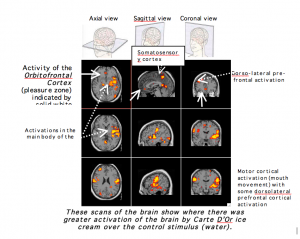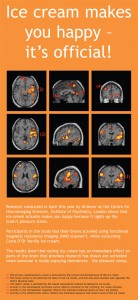Ice Cream makes you happy

Changes in brain activity related to eating Carte D’Or ice cream
1. Background and Rationale
Recent research has employed brain imaging technologies to do two things of interest to us: (1) to investigate the neural underpinnings of the reward value of different food stimuli (how our brains determine if something is pleasant or pleasurable or not)
(2) to try and understand why a consumer responds or behaves in the way they do without having to use verbal report (which only provides information of which the consumer is aware and may be rationalised to make it more understandable to that consumer or the person asking).
Other brain imaging research has shown that there is an area of the frontal brain (the orbitofrontal cortex or OFC) that seems to be involved in representing the emotional aspects of food products. The OFC is activated when there is a reward value to the stimulus i.e. a pleasurable or painful stimulus, these stimuli activating different areas within the OFC. The OFC does not respond to mundane stimuli (e.g. ordinary food). In fact it you damage the OFC people’s emotions are neutered.
We know from what consumers tell us that ice cream is considered a highly pleasurable food, is often eaten as a treat or indulgence, has unique and very pleasing sensory properties and is strongly associated with positive memories and experiences. This is what makes people want to eat ice cream. While we strive to improve the nutritional profiles of our products (for consumption as part of a balanced diet) it is essential that we maintain this pleasurable experience and also to show that the pleasure itself makes us happy, which in turn is beneficial for our health.
To measure objectively whether ice cream is pleasurable, and therefore makes us happy, we can use brain imaging to see whether ice cream activates the pleasure/reward centre of our brains (the OFC).
2. Goal of the Study
The goal of this study was to provide scientific evidence that “ice cream makes you happy” by demonstrating that the OFC (the pleasure/reward centre of the brain) is activated by consumption of Carte D’Or ice cream, using fMRI brain imaging.
3. Research Investigators
The study was run at the Centre for Neuroimaging Sciences, Institute of Psychiatry, London in collaboration with Professor of Neuroimaging, Michael Brammer. The study was designed and overseen by Unilever’s cognitive neuroscientist Professor Francis McGlone and managed by Dr Amanda Mistlin.
- Study Design
4.1. Participants
8 graduate and post-graduate staff at the Institute of Psychiatry participated in the study. They were chosen because they were all familiar with being in the scanner for the time needed (i.e. wouldn’t be anxious and would provide usable brain images), and were all happy to eat ice cream. None of them had any prior knowledge of this study.
4.2. Protocol
Prior to going into the scanner the participants were talked through the protocol and laid on the ground to receive a trial ice cream sample (to mimic how they would receive the sample in the brain imager). They were asked to rate how much they liked the ice cream on a 5-point scale (from +2 to -2).
In the scanner room the participant was laid down on the scanner table, with headphones on, and with their head encased in a frame. The frame acts as a radio receiver to sense the signals emitted from the brain. The participant is then slid into the bore of the fMRI scanner and given a preparatory scan.
Then the experiment with the ice cream begins. The participant is given a pipette of warm water, directed into their mouth (to cleanse/clear their palette). Thirty seconds later they receive their first sample of ice cream (~2g). The ice cream is delivered on the handle of a teaspoon by someone leaning into the bore of the scanner, and placing the end of the teaspoon between their lips. The aim is to do this with no head movement of the participant as this interferes with the scanning signal. The subject was advised to let it melt in the mouth as naturally as possible and then gently swallow. Each participant received 15 samples of ice cream in total, each 1 minute apart. Every 30 seconds after ice cream delivery the subject received a pipette of warm water to cleanse their mouth. This water acted as the control stimulus for the ice cream.
At the end of the ice cream feeding trial the participant is again scanned to get an anatomical view of their brain onto which the brain activation is mapped.
The whole session took approximately 30 minutes. At the end of the session the participant was again asked to rate how much they now liked the ice cream.
4.3. Products
Carte D’Or Vanilla Ice Cream, stored and served at the recommended temperature, was used in this study.
4.4. fMRI Scanner
We used a 3T (Tesla) scanner for this study to ensure sufficient power and resolution to see the areas of interest in the brain.
fMRI works by detecting local changes in blood flow in areas of the brain that are engaged in some form of mental event. The brain’s cells – neurones – are very dependent upon a good supply of nutrients, so when a specific area is processing a particular sensory input, e.g. the taste of ice cream, cells in the primary taste cortex increase their activity, thereby causing a local increase in blood supply to that specific area of the brain.
Subjects participating in fMRI experiments are placed inside very strong magnets, which literally magnetise them, polarising all the hydrogen nuclei (we are mostly water) so that their protons are aligned with the magnetic field of the magnet. Using radio frequency pulses (RF) these protons are briefly kicked out of alignment and when they relax back to their pre-disturbed state, emit a tiny RF signal. This is detected, localised by some very clever software analysis and eventually reconstructed to give a picture of the brain that reveals where the activity related to the stimulus was occurring.
When the brain is scanned a full volume image of the brain is created. This is sliced like salami into approximately 12-15 slices. This is done 3 times to get 3 volumes with 36 or more slices. This slice is further divided up into squares (voxels). Each one of these registers any change in the MR signal which is produced by the RF pulses and depends upon the level of deoxygenation in the vasculature within that voxel. If the neurones are active, the blood flow goes up, the balance of oxy to deoxy changes and you get, or don’t get, a signal change – the haemodynamic response function (HRF). You look at the HRF’s in particular brain areas correlated with the stimulus-on period (when ice cream is present) and subtract the no-stimulus condition (water) – using statistical t-tests you see which areas were significantly activated when your stimulus was present. The analysis was carried out using a statistical package written by Professor Brammer.
- 5. Results
What we were hoping to find, and did find, was that eating ice cream activates the part of the brain called the Orbitofrontal cortex (OFC), which indicates the positive emotional pleasure and reward value of the ice cream.
We also found activation in other areas of the brain:
- The primary somatosensory cortex – activated by the texture and temperature of the ice cream
- The insula cortex – activated by the taste of the ice cream. This area also monitors and regulates the body’s physical state.
- The motor cortex – activated by the mouth movements involved in eating this ice cream.
- The dorso-lateral prefrontal cortex. Activity in this area reflects attention to the ‘exciting’ ice cream stimulus.
- The retro-splenial cyngulate. Activity here reflects the internal emotional check on how I am feeling.
The following brain image slices show this activation.

- Conclusions
Carte D’Or ice cream does light up the pleasure centre of the brain. It also activates other areas of the brain involved in sensory processing of the stimulus as expected, and activates areas of the brain involved in attention and processing of emotionally relevant stimuli.
Does pleasure equal happiness? Yes, because according to the field of Positive Psychology, happiness is simply a measure of positive feeling or emotion.
Do other foods stimulate the same area? Other foods with equally sensational sensory characteristics and a strong emotional value might light up the OFC, but we haven’t measured them. In fact, it is pioneering research to actually test foods with an fMRI scanner because typically you have to avoid any head movements associated with chewing. Ingestive behaviour is technically very demanding. We have been able to look at ice cream only because it is a semi-solid food, and because of the clever analysis available to compensate for stimulus-correlated motion. There has been a PET research study (Positron Emission Topography), not fMRI, using chocolate where activation of the OFC was found. Chocolate too is a unique combination of sensory characteristics, with melting properties like ice cream, with strong emotional valence. We have the benefit of combining ice cream and chocolate in some of our products – two pleasure zone activators – which maybe explains why this combination is so loved.

